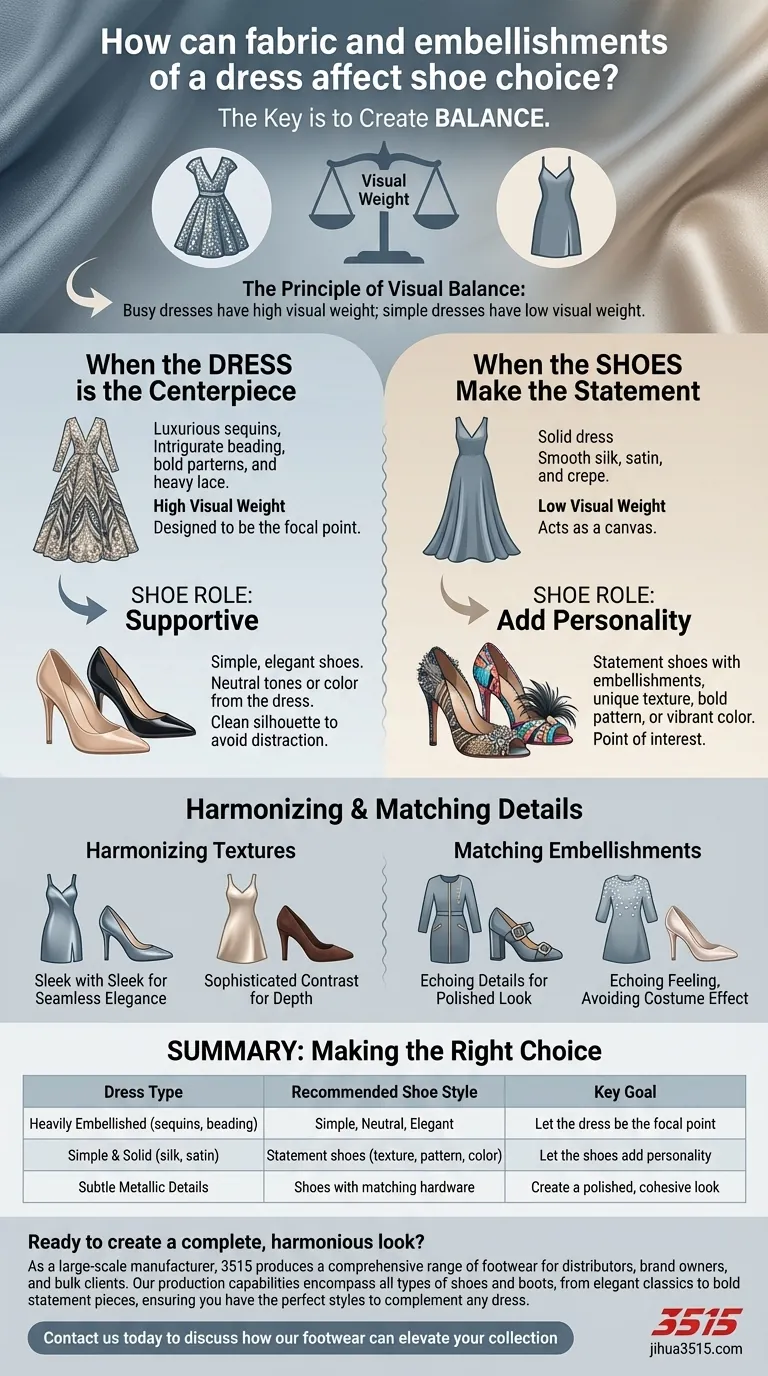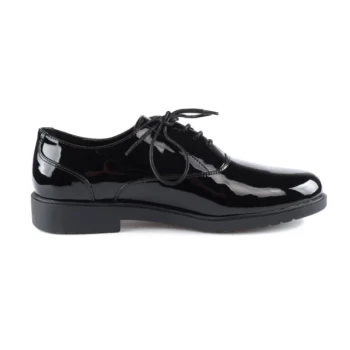The key is to create balance. The fabric and embellishments of a dress dictate its "visual weight." A simple, unadorned dress made of a solid fabric like silk or satin acts as a canvas, allowing for more expressive shoes with patterns or details. Conversely, a dress that is already heavily embellished requires a simpler, understated shoe to avoid creating visual clutter.
Choosing the right shoes is about creating a deliberate conversation between the dress and your footwear. Your shoes should either complement the dress's statement or become the statement themselves—they should never compete with it.

The Principle of Visual Balance
The core concept for pairing shoes with a dress is "visual weight." This refers to how much a garment attracts the eye. A busy, detailed dress has high visual weight, while a simple, solid dress has low visual weight. Your goal is to balance the total look.
When the Dress is the Centerpiece
Dresses with significant embellishments—such as sequins, intricate beading, bold patterns, or heavy lace—already have high visual weight. They are designed to be the focal point.
In this case, the shoe's role is purely supportive. Opt for simple, elegant shoes in a neutral tone (nude, black, metallic) or a color pulled directly from the dress. The shoe's silhouette should be clean and classic to avoid distracting from the main garment.
When the Shoes Make the Statement
A dress made from a plain, solid material like silk, satin, or crepe has low visual weight. This creates an opportunity for your shoes to add personality and become a central part of the outfit.
This is the perfect time to choose shoes with their own embellishments, a unique texture, a bold pattern, or a vibrant color. They add a point of interest without having to compete for attention.
Harmonizing Fabric Textures
The texture of the dress fabric also influences shoe choice. A sleek, smooth fabric like satin pairs beautifully with an equally sleek shoe for a seamless, elegant look.
Alternatively, you can create a sophisticated contrast. Pairing a smooth satin dress with shoes in a rich texture like suede can add depth and dimension to the overall ensemble.
Matching Embellishment Styles
If you're aiming for a highly cohesive look, pay close attention to the specific details on the dress.
Echoing the Details
A dress with subtle metallic accents, like a silver zipper or gold buttons, provides a clear cue. Choosing a shoe with similar metallic hardware creates a polished, intentional, and high-end feel.
This technique shows a thoughtful approach to styling, tying the entire look together from head to toe.
Avoiding the "Costume" Effect
Be cautious not to over-match. A dress covered in pearls does not require a shoe also covered in pearls; this can often look dated or more like a costume than a sophisticated outfit.
Instead of matching the embellishment one-for-one, echo its feeling. For a dress with pearlescent beads, a shoe with a soft, lustrous sheen would be a more modern and elegant choice.
Understanding the Trade-offs
Making the right choice involves balancing style with sophistication and avoiding common pitfalls.
Simplicity vs. Being Plain
A simple shoe is the correct choice for a busy dress, but "simple" should not mean "boring" or "poorly made." The shoe should still be high-quality, with an elegant shape and fine construction.
A cheap or clunky shoe, no matter how simple, will bring down the quality of the entire outfit. A well-crafted shoe elevates your appearance, even when it isn't the focal point.
Boldness vs. Visual Noise
A statement shoe is a fantastic way to elevate a simple dress. However, the shoe's style must still be in harmony with the dress.
If the embellishments on the shoe clash in style, color, or formality with the dress, the result is not a "pop" of interest but distracting visual noise. The goal is a confident statement, not a chaotic one.
Making the Right Choice for Your Dress
Use the dress itself as your guide to determine what kind of shoe will complete your look most effectively.
- If your dress is heavily embellished (sequins, beading, intricate lace): Opt for simple, elegant shoes in a neutral or complementary color to allow the dress to remain the focal point.
- If your dress is a solid color with a simple fabric (silk, satin, crepe): Use this as an opportunity to wear statement shoes with unique textures, patterns, or embellishments.
- If your dress has subtle metallic or hardware details: Consider a shoe with matching hardware to create a cohesive and thoughtfully polished look.
Ultimately, your choice of shoe should help create a single, harmonious silhouette where every element works in concert.
Summary Table:
| Dress Type | Recommended Shoe Style | Key Goal |
|---|---|---|
| Heavily Embellished (sequins, beading) | Simple, neutral, elegant | Let the dress be the focal point |
| Simple & Solid (silk, satin) | Statement shoes (texture, pattern, color) | Let the shoes add personality |
| Subtle Metallic Details | Shoes with matching hardware | Create a polished, cohesive look |
Ready to create a complete, harmonious look?
As a large-scale manufacturer, 3515 produces a comprehensive range of footwear for distributors, brand owners, and bulk clients. Our production capabilities encompass all types of shoes and boots, from elegant classics to bold statement pieces, ensuring you have the perfect styles to complement any dress.
Contact us today to discuss how our footwear can elevate your collection and meet your customers' styling needs.
Visual Guide

Related Products
- Custom Manufactured Air Cushion Leather Business Shoes for Wholesale
- Wholesale Classic Leather Lace-Up Ankle Boots for Brand Manufacturing
- Wholesale Comfortable Business Casual Shoes Custom Manufacturing
- Wholesale Leather Derby Shoes Manufacturer | Customizable Business & Dress Footwear
- Wholesale Women's Leather Derby Shoes Custom Factory Production
People Also Ask
- What are the characteristics of business casual sneakers? Master the Polished & Professional Look
- Are sneakers appropriate for business casual settings? A Guide to Modern Office Footwear
- What are the benefits of calf leather for dress shoes? Unmatched Elegance & Comfort
- Can sneakers be part of a business casual wardrobe? Yes, with the right style and fit
- How does leather compare to other shoe materials in terms of durability and comfort? A Material Guide for Footwear



















